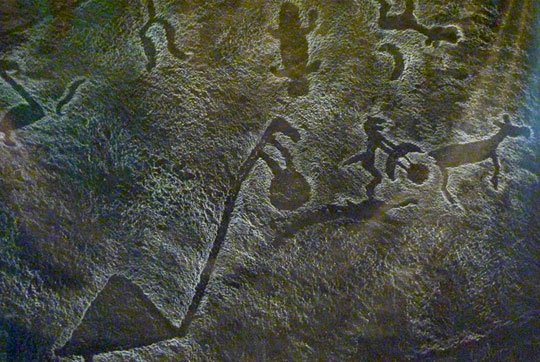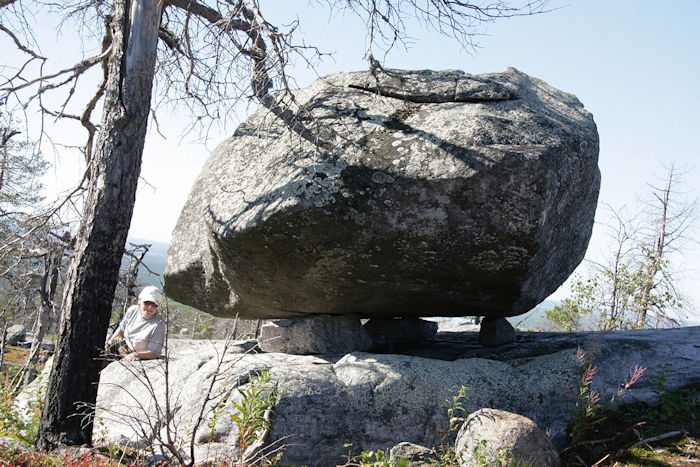Ancient Secrets Of Karelia: Mysterious Vottovaara Mountain Was Sacred To The Sami People
Ellen Lloyd - AncientPages.com - Many ancient civilizations believed spirits lived in sacred places such as trees, mountains, and stones.
One such place is the mysterious Vottovarra Mountain in Karelia, sacred to the Sami people. This enigmatic place was also an ancient pagan site and is still visited by neo-pagans who consider it particularly important.
Karelia has always been an area in Northern Europe of historical significance for Finland, Russia, and Sweden.
Swamp or lake and megalithic seid boulder stones, dead trees on mountain Vottovaara. Credit: Adobe Stock - geniousha
Archaeologists have uncovered many fascinating rock carvings in the region. On the eastern bank of Lake Onega, the second largest lake in Europe, archaeologists discovered about 1,200 rock drawings estimated to be from 5 to 6 thousand years old.
Known as the Onega petroglyphs, these astonishing rock carvings were deliberately made to display stunning special light effects, just like a prehistoric cinema.
Finn-Ugrick rock art from the Karelian Lake Onega region of Russia. Image credit: David Rothenberg.
Another intriguing site in Karelia is located about 20 kilometers from Sukkozero Lake. Here we find the beautiful Vottovaara Mountain, which became famous for its odd boulders scattered across the site.
The boulders known as Seida, Seyda, or Seid (Finnish language Seita) were sacred to the Sami culture, the oldest culture in large areas of northern Europe. Before the Swedish, Finnish, or Viking culture had developed, Scandinavia was populated by the Sami people (earlier referred to as the Saemieh).
The Sami people speak a language that is a member of the Uralic language family, along with Finnish, Hungarian, and Estonian languages. Interestingly, Norwegian and other Indo-European languages are unrelated to the Sami language.
The unusual thing about Vottovaara seidas is that many of them look like they were intricately cut, but they are natural formations when the glacial ice retreated about 10,000 years ago. Seidas are holy places related to Sámi culture. Seidas are usually situated on gentle rocky slopes and can be very large.
Vottovaara Mountain - Maximaximax - CC BY-SA 3.0
The ancient Sami people considered the boulders sacred and believed spirits lived in these magical, large stones. Before Christianity, traditional Sami peoples' beliefs were based on the practice of shamanism and animism.
Animism was manifested in that all significant natural objects, such as animals, plants, rocks, and many others, possessed a soul. So, it's only natural that the Sami people also believed in the existence of many spirits.
Updated on August 26, 2024
Written by Ellen Lloyd – AncientPages.com
Copyright © AncientPages.com All rights reserved. This material may not be published, broadcast, rewritten or redistributed in whole or part without the express written permission of AncientPages.com
Expand for referencesMore From Ancient Pages
-
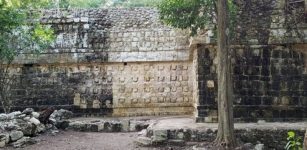 Large Palace Discovered At Mayan City Of Kulubá In Yucatan, Mexico
Archaeology | Dec 27, 2019
Large Palace Discovered At Mayan City Of Kulubá In Yucatan, Mexico
Archaeology | Dec 27, 2019 -
 Lady Midday – ‘Poludnica’- An Evil, Elusive Female Field-Spirit In Slavic Beliefs That Comes To Kill At Noon
Featured Stories | Jan 7, 2019
Lady Midday – ‘Poludnica’- An Evil, Elusive Female Field-Spirit In Slavic Beliefs That Comes To Kill At Noon
Featured Stories | Jan 7, 2019 -
 Unique Viking Age Arm Ring Found On Öland And Stunning 2,000-Year-Old Gold Torc Discovered In Trollhättan, Sweden
Archaeology | Mar 19, 2025
Unique Viking Age Arm Ring Found On Öland And Stunning 2,000-Year-Old Gold Torc Discovered In Trollhättan, Sweden
Archaeology | Mar 19, 2025 -
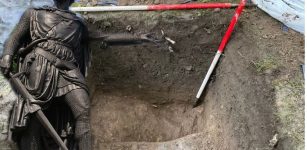 Most Important Road In Scottish History Found In The Garden Of The Old Inn Cottage Near Stirling
Archaeology | Nov 16, 2023
Most Important Road In Scottish History Found In The Garden Of The Old Inn Cottage Near Stirling
Archaeology | Nov 16, 2023 -
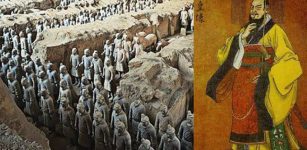 Mysterious History Of Qin Shi Huang – First Emperor Of China
Featured Stories | Jan 17, 2016
Mysterious History Of Qin Shi Huang – First Emperor Of China
Featured Stories | Jan 17, 2016 -
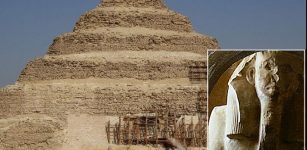 New Theory On “Dry Moat” At The Pyramid Of Pharaoh Djoser
Archaeology | Jul 3, 2019
New Theory On “Dry Moat” At The Pyramid Of Pharaoh Djoser
Archaeology | Jul 3, 2019 -
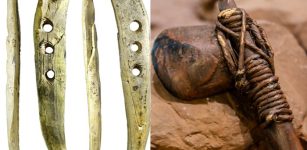 Rare Mammoth Ivory Tool Offers Evidence Of Ropemaking In Central Europe More Than 35,000 Years Ago
Archaeology | Feb 5, 2024
Rare Mammoth Ivory Tool Offers Evidence Of Ropemaking In Central Europe More Than 35,000 Years Ago
Archaeology | Feb 5, 2024 -
 Ancient DNA Helps Reveal Social Changes In Africa 50,000 Years Ago That Shaped The Human Story
DNA | Jun 7, 2022
Ancient DNA Helps Reveal Social Changes In Africa 50,000 Years Ago That Shaped The Human Story
DNA | Jun 7, 2022 -
 Re-Writing History Of England’s Domesday Book Of William I The Conqueror
Archaeology | Nov 27, 2018
Re-Writing History Of England’s Domesday Book Of William I The Conqueror
Archaeology | Nov 27, 2018 -
 On This Day In History: James Cook – Navigator And Explorer – Killed On Feb 14, 1779
News | Feb 14, 2017
On This Day In History: James Cook – Navigator And Explorer – Killed On Feb 14, 1779
News | Feb 14, 2017 -
 Oldest Cyrillic Inscriptions Dated To The Time Of King Simeon the Great – Discovered
Archaeology | May 3, 2023
Oldest Cyrillic Inscriptions Dated To The Time Of King Simeon the Great – Discovered
Archaeology | May 3, 2023 -
 The Spread Of Weighing Systems Across Western Eurasia 4,000 Years Ago
Archaeology | Jun 30, 2021
The Spread Of Weighing Systems Across Western Eurasia 4,000 Years Ago
Archaeology | Jun 30, 2021 -
 Those Who Mysteriously Disappeared To A World Beyond Human Understanding
Featured Stories | Apr 30, 2019
Those Who Mysteriously Disappeared To A World Beyond Human Understanding
Featured Stories | Apr 30, 2019 -
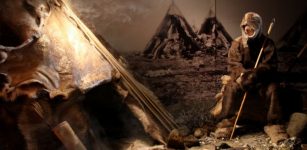 12,000-Year-Old Ice Age Stone Tools Found – Earliest Dated Evidence For Human Activity in Scotland
Archaeology | Oct 10, 2015
12,000-Year-Old Ice Age Stone Tools Found – Earliest Dated Evidence For Human Activity in Scotland
Archaeology | Oct 10, 2015 -
 Knowledge Of Divine Alien Beings And High-Tech In Ancient Egypt Described In Sacred Books And Papyrus – The God Who Spoke About Time Dilation – Part 1
Ancient Mysteries | May 12, 2021
Knowledge Of Divine Alien Beings And High-Tech In Ancient Egypt Described In Sacred Books And Papyrus – The God Who Spoke About Time Dilation – Part 1
Ancient Mysteries | May 12, 2021 -
 Advanced Ancient Civilization’s Encounter With Primitive People Led To Something Extraordinary – Thought-Provoking Theory Suggests
Ancient Mysteries | Dec 19, 2018
Advanced Ancient Civilization’s Encounter With Primitive People Led To Something Extraordinary – Thought-Provoking Theory Suggests
Ancient Mysteries | Dec 19, 2018 -
 Manx: Ancient Dead Gaelic Language That Refused To Die And Has Been Revived Again
Ancient History Facts | Oct 7, 2016
Manx: Ancient Dead Gaelic Language That Refused To Die And Has Been Revived Again
Ancient History Facts | Oct 7, 2016 -
 Gog And Magog Prophecy In The Book Of Revelation
Biblical Mysteries | Oct 11, 2018
Gog And Magog Prophecy In The Book Of Revelation
Biblical Mysteries | Oct 11, 2018 -
 First Evidence Common People Drank Wine In Troy (Not Just The Elites)
Archaeology | Mar 31, 2025
First Evidence Common People Drank Wine In Troy (Not Just The Elites)
Archaeology | Mar 31, 2025 -
 On This Day In History: Tokugawa Shogunate Begins In Japan After Historical Battle – On Oct 21, 1600
News | Oct 21, 2016
On This Day In History: Tokugawa Shogunate Begins In Japan After Historical Battle – On Oct 21, 1600
News | Oct 21, 2016


